People often ask me why you grow so much and so abundantly with such a high yield. Here you can take a look at one of my prime examples: Hokkaido pumpkin, kale, tomatoes, tree spinach and sunflowers. Everything grows together in a 60 cm long balcony box. Worm humus, which I have been adding to my garden for 5 years, plays a big part. Worm box and use it to fertilize the plants on the balcony. I am thrilled that we are creating a natural cycle in our home. My sustainable worm bin has been in place since May 2015 years in my kitchen and is used continuously. Here you can read my experience report on worm humus on the balcony, including the horticultural use. I bought one of the first stylish worm boxes from developer David Witzeneder and love it very much. It has castors underneath, is mobile and has a padded seat cushion. We have a great relationship. I hope you also want to fertilize with worm humus on your balcony and reap great harvests :). It’s the best natural sustainable fertilizer for non-toxic organic gardening.
What is a worm bin?
I love to throw the leftovers into the worm bin straight after chopping fruit and vegetables. Open the lid, put in the organic waste, close the lid again. This is where our compost worms live, feeding on our kitchen waste and in return pooping out the best fertilizer, called worm humus. They do nothing else in the worm bin day after day but feed, poop and reproduce. My worm box is called a worm box because my compost worms live in a wooden box. Other names for these “compost heaps” suitable for living in are worm farm, worm compost, worm cafe’. All serve the purpose of composting kitchen waste. Wonderfully suitable for homes.

Setting up a worm box
It doesn’t stink, I promise. A slight smell of forest, definitely pleasant. My crate has wheels underneath. I can roll it back and forth, which is an advantage when cleaning. My worm box has a cushion on top. So you can sit on the crate. That’s an advantage for parties in the kitchen. It’s also always a topic of conversation — who has 1000 pets in the kitchen? The earthworms have never escaped from my worm box. They feel at home with me. I replaced the first fabric cover after 3 years of use. I noticed that I had to touch it every day to open the lid to put the organic waste in. So far I have not had any problems with mold in the worm bin, although this can occur if it is not used properly. I have had problems with fruit flies, but they fly in my house in summer anyway. If contaminated fruit scraps are placed in the wormery, they will naturally continue to multiply there. It helps to place a hemp mat on top. Very good instructions are supplied. It explains in detail that fresh fruit and vegetable scraps, cuttings from balcony plants, coffee or tea grounds are all suitable. Around 20 % shredded newspapers or torn cardboard boxes can/should be added. Meat, cooked leftovers and citrus fruits are not suitable. The instructions contain recommendations on what to do if difficulties arise and at what point adjustments should be made. The manufacturer’s support is impeccable and is praised. Even the Website is very informative. Setting up the worm bin works without any problems. Everything is explained in detail in the instructions, including how much food to put in at the beginning. The amount of food is then gradually increased. The number of worms always adjusts to the amount of food. I removed the first worm humus after 5 months and since then I have regularly added it 4 times a year. Every year 20 liters. At intervals it is necessary to give the worms a mineral mixture so that they have a complete diet. You can of course also get this from the manufacturer.
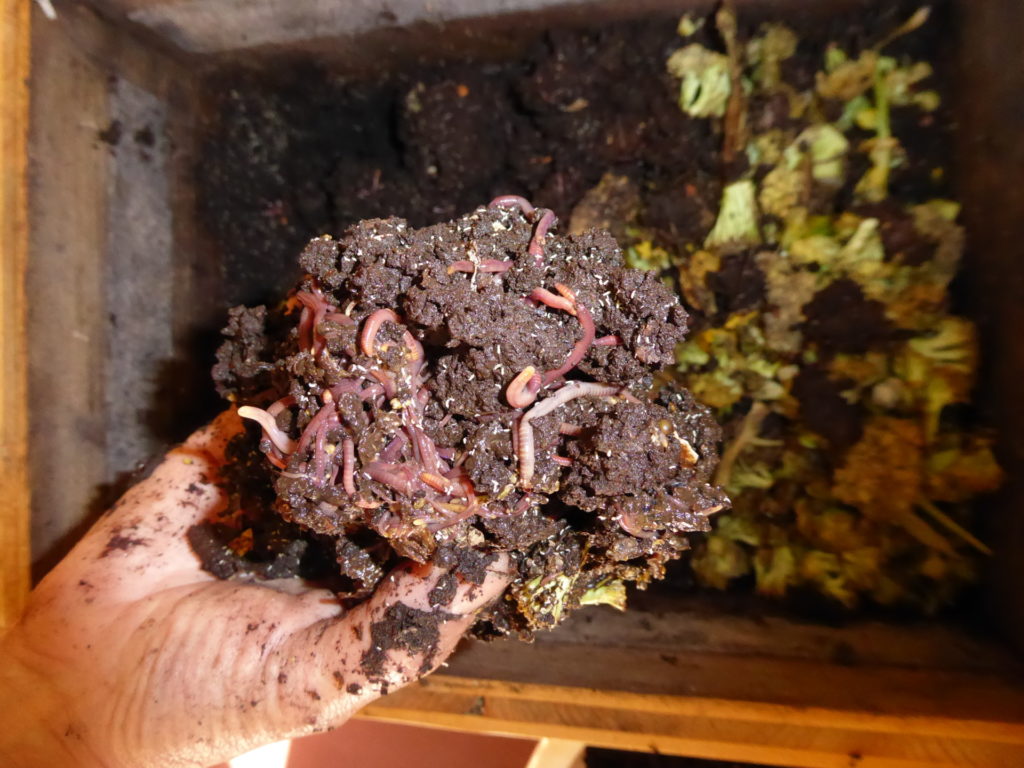
What are the benefits of worm humus for the balcony?
The worms look like smaller earthworms, but they are compost worms. I use a worm mix. They eat their way through the parts of the shredded fruit and vegetable waste that have been decomposed by microorganisms. They also eat shredded paper and cardboard. The digested material is then the most valuable fertilizer that I use for my balcony plants — worm humus for my balcony. Worm humus is even called “black gold” because its fertilizing power is enormous. Full of nutrients and, above all, full of microorganisms, which we want in organic gardening. Soil organisms for our balcony boxes. Worm humus is quite expensive in the shops. Packaged in plastic containers. Often stands for a long time. The microorganisms may no longer be alive by then. I, on the other hand, harvest it 4 times a year and distribute it immediately to the plant pots. I make 20 liters of worm humus per year, which is a lot. In my organic store, 5 liters of worm humus cost 9.50 EUR. I have had good harvests with this great fertilizer. This stylish box gives me a very good feeling.
My sustainable wooden worm bin comes from Austria. I interviewed David Witzeneder for the Online Organic Balcony Congress 2017 and 2020.

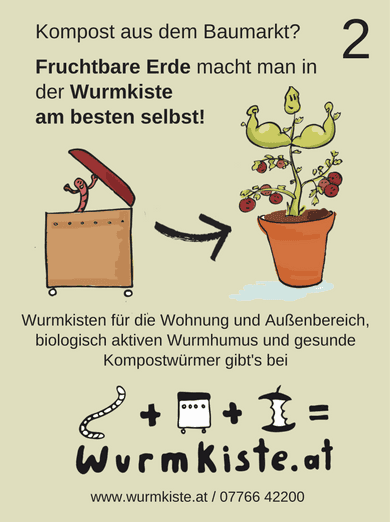
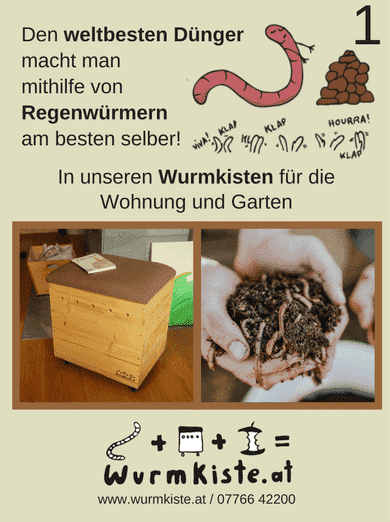
Gardening with worm humus on the balcony: How to fertilize with worm humus?
With odorless worm composting, the nutrients are Nitrogen, Phosphate, Potassium, Calcium and Magnesium and Minerals firmly in Clay-humus complexes and are continuously released over a longer period of time. Worm humus causes a Loosening the soil and increases the Water storage capacity. It contains a lot Silicic acidwhich strengthens the cell walls of plants. Simple 10 % work in superficially or Mix 1:10 with soil, for heavy eaters (e.g. tomatoes, zucchinis, pumpkin, large-fruited peppers) 1:15. The accumulating Seepage liquid, Worm tea called, serves Diluted 1:5 as a liquid fertilizer. This is also great for indoor plants in the home. Ready-made worm humus for the balcony can also be purchased in organic stores or online.
I spread the worm humus on the balcony on days when the sun isn’t shining. I don’t want the delicate, important soil organisms to be destroyed by the sun. It is important when using it for gardening that Mulching the plantersThis means covering the surface of the soil with organic material such as grass cuttings, chopped herbs such as nettles containing nitrogen or comfrey containing potassium, leaf material removed during plant care, etc. The soil organisms present in the soil due to the vermicompost decompose this organic material, which in turn has a fertilizing effect. Mulching also always has the effect of reducing water evaporation, as the surface of the planters is protected from evaporation.
The harvested worm humus often still contains Earthworms available. They are allowed in my planters. I know that the earthworms, in conjunction with the soil organisms, decompose the organic material and organic fertilizer in the planter, which has a fine fertilizing effect. In addition, earthworms always loosen the soil. What works perfectly in the field, namely earthworms in the soil, also works in large planters. I have never had any plants die because of them. I can always see blackbirds pulling earthworms out of the planters. Of course, this attracts the blackbirds in particular, who rummage through the surface of the planters in search of earthworms. I have already seen a blackbird pull three earthworms out of a balcony box in rainy weather in early March. I was really happy about this because I could see that the earthworms had survived the winter in the balcony box and not just the eggs (cocoons).
When planting tomatoes and peppers, the first thing that comes to mind is Basic fertilization an extra portion of worm humus into the planting hole. I never completely replace the soil in spring, as is so often the case. I use the worm humus to spice up my used soil. I sprinkle worm humus on top of the planters and loosen the soil surface with an old spoon or fork so that the worm humus is worked in. Before planting new plants, balcony boxes can be emptied in spring in a huge bowl, bucket or on an empty, cut open bag of soil, the roots removed, mixed with 10 % worm humus and filled back into the planters. You can find other ways to spice up old soil here read. In the course of the season, the Top dressing simply sprinkle 10 % (15 % for heavy eaters) of worm humus on the surface of the planters and work it in a little.
Worm humus is the basis for compost tea. Compost tea is a great inexpensive way to revitalize the soil. It also has a fertilizing effect. Soil bought in DIY stores or garden centers has been heated to a high temperature. This is why it contains hardly any soil organisms, as is normal in nature.
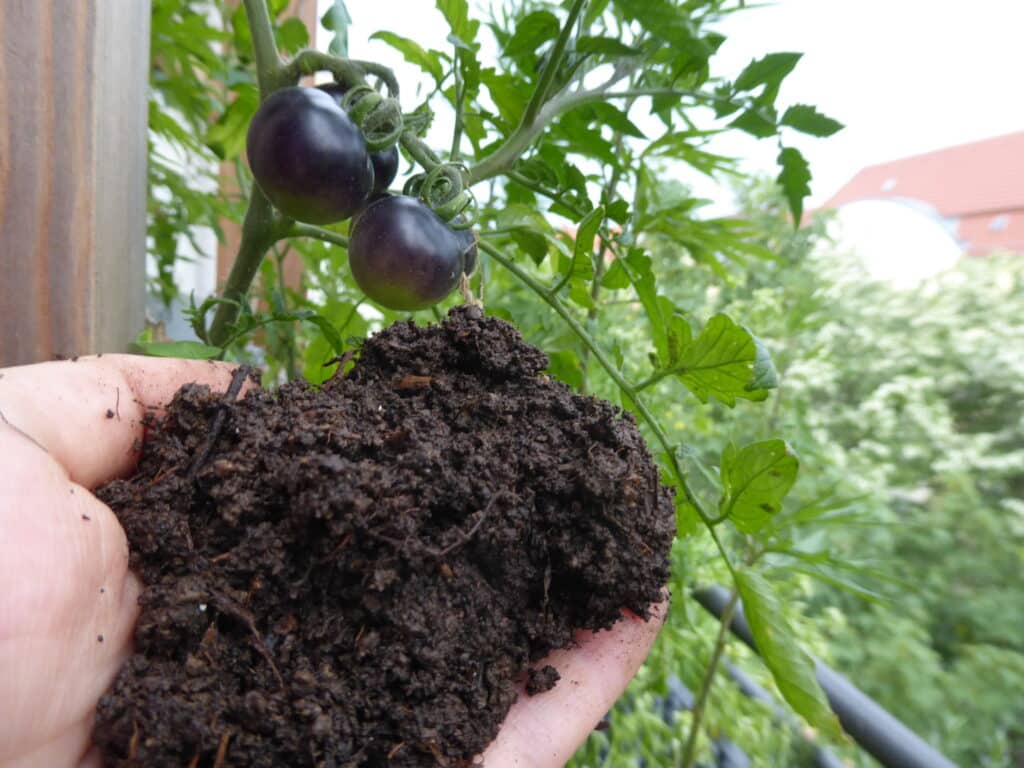
Put the worm box on the balcony?
The box can be placed in the kitchen, but also in the hallway, cellar, bedroom or garage. It is too hot on a south-facing balcony in midsummer; the microorganisms and compost worms cannot survive this. The compost worms stop their activity at around 5 °C, and only the eggs (cocoons) survive in frost. Of course, it takes time for a box to freeze through. The box can be protected against the cold with blankets or other insulating material, but at temperatures below 5 °C and above 30 °C it simply does not belong on the balcony. It should be protected from the rain and not exposed to the blazing sun. Mine is in the kitchen and I love the fact that I can put the waste in the box as soon as I’ve finished chopping the vegetables. They are gone.
Worm bins for schools
There are now even observation worm boxes for schools. These two are maintained at my son’s school. The first graders take turns feeding the worms. They are very interested in the worms, which can be used to teach a lot about natural cycles.

I found it very creative that the first graders gave the worms names. They had a lot of work to do when they first filled such a new worm box, writing 500 names on a long piece of paper, which of course had the shape of a worm. A fun way to practise writing.

Conclusion: It really doesn’t stink
The best. A worm bin doesn’t stink. The contents smell pleasantly of the forest floor. I love them and wouldn’t want to be without them. I think every household should put its organic waste in a worm bin and use it to grow new vegetables on the balcony or windowsill.
Despite the worm crate, I always went on vacation. If you go on vacation for two weeks, you put more food in the box before you leave. From three weeks’ vacation, a worm sitter is necessary — but so is a watering service. He then also took care of the worms.
From my five years of experience, I can say that the plants develop a strong root system, are not susceptible to disease and produce lots of fruit. With worm humus, there is no risk of over-fertilization.
My conclusion: Worm humus is the best natural fertilizer for the balcony. Sustainable. A cycle.
Workshop on building your own worm box for the balcony
Another funny thing. First, my son built his own little worm box out of a cardboard box and looked after it.

In 2019, he built his own worm box in a workshop with David Witzeneder. Perhaps you also have the opportunity to build your own worm box in your area. Building a worm box. It was a great day. It is now in our son’s bedroom under his bunk bed. Sometimes we can even hear the worms smacking their lips :).
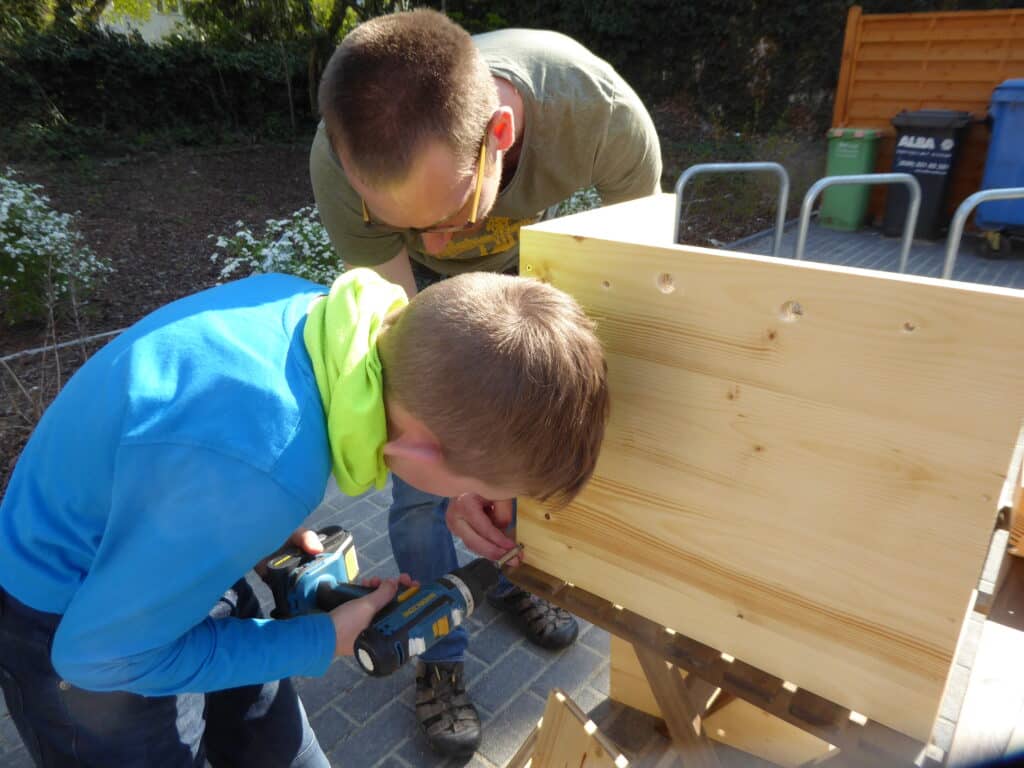

We are a bit crazy. It’s just great to have your own organic waste converted into the best organic fertilizer by 1000 worms. You can then spread this worm humus on the balcony boxes and reap super harvests.
What do you think about a worm box? Have I aroused your interest? Do you have any concerns or questions? For me, it’s the best fertilizer.
In my Book worm humus plays a key role as the best organic fertilizer. I find it so valuable that we can very successfully recreate a natural cycle in the home. I also explain the differences to bokashi, another natural fertilization method.
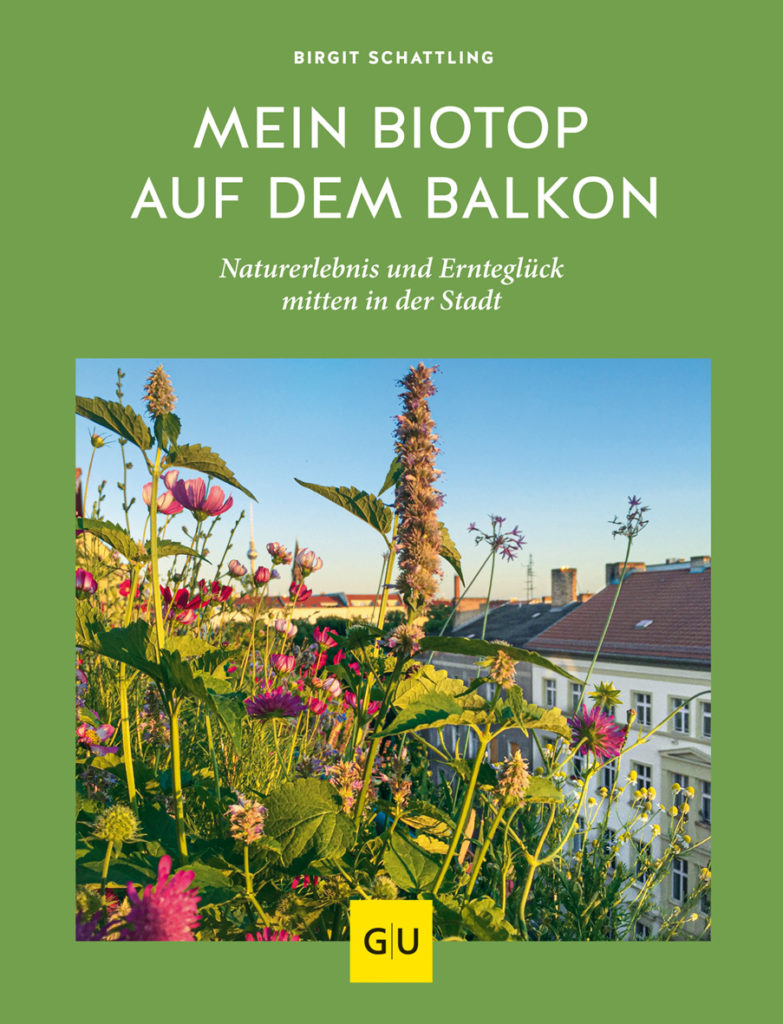
You can access the worm box here.
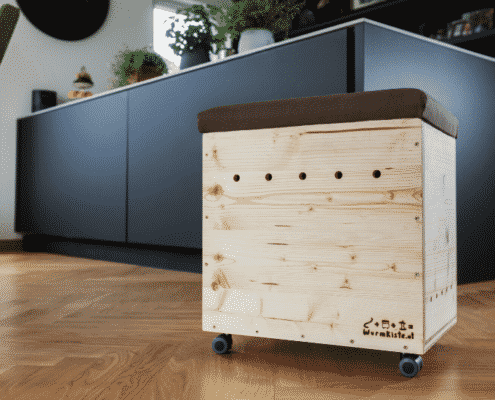
To the operating instructions the worm box

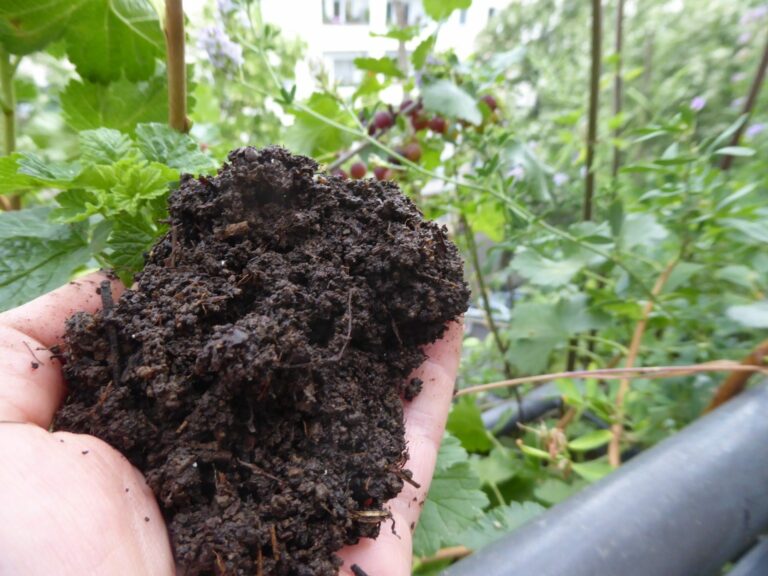







15 Responses
Great, thank you, hello, dear organic balcony team, “big & small” so to speak —
I’m just now reading this beautifully illustrated & detailed article about THE worm box, which I first discovered & was introduced to by you at the “online congress” (I think)! Thank you — thank you — thank you. The blog article is again so well written, as usual “relaxed and fluffy” — “from the pen”; as always very nice and lively to read; also very comprehensive, understandable on all sides & all-round encouraging, practical & informative. As always, I am thrilled.
“Every” (-; well ;- ) household should have one of these ingenious worm bins. I find these organic waste garbage cans (also in our house) extremely “questionable”. But I want to write positively. So I imagine (once again) having one of these bins and even building one. “Every” city (;- well 😉) should have such a communal (publicly funded) “worm-box-wood-workshop” for the citizens. Especially for schoolchildren!
Happy New Year greetings, January 20, 2020; K.
Thank you for this wonderful comment. I really like it. I agree that a worm box like this belongs in every household. Then there will be one for you too ? Kind regards Birgit
Hello Birgit,
I have also had a worm bin since October ’20 (2‑person household). I have just harvested worm humus for the first time. I wanted to wait until I was ready to grow tomatoes and zucchinis.
1st question: how and for how long can I store worm humus that I do not use immediately?
2nd question: if I want to make worm tea from one part, can I add 1 tablespoon to a 5- or 10-liter watering can?
3. how and for how long can the worm tea be kept in the jar? Do I have to stir it from time to time to introduce oxygen?
4th question: can I dry the worm humus and then preserve it for longer? If so, how do I dry it?
5. while harvesting, I noticed that there was a very dense layer of not yet fully decomposed material at the bottom of the basket. I have now put the contents of the basket into the box, inserted the basket and carefully loosened this dense layer. Could it be that I have fed too quickly/too much? I have a lot of springtails in the box and horn mites from time to time. It has never stunk and I have never had flies.
Incidentally, I would find the presentations at the 7th Bio-BalkonKongress, which focused on soil, highly interesting and exciting.
I worked very carefully when harvesting the worm humus, thinking all the time that it was a living thing.
LG
Doro
Dear Doro, these are questions to be answered by wurmkiste.at. I am a fan of Wurmkiste and a user, but not the provider. I’m sure you understand that. Please always check their website first if you have any questions https://wurmkiste.at/ which is now very well organized. I’m sorry, but for time reasons I’ll refer you to the team there, I can’t afford the time, I organize the lives and a special opening of the interviews. I’m really pleased that you said that you worked carefully. It’s a small ecosystem that is settling in. For Saturday 1.5. 5 pm I have organized a live with the two girls from Hubus, who also offer compost furniture. You can still ask questions live there. They are also experts. Kind regards Birgit
Dear Birgit, if I get a worm bin how long is it before I can harvest compost?
I will gladly revitalize my balcony soil as I have learned in your wonderful balcony congress. Do you think it is too much if I mix my soil with Terra Preta and also put sheep’s wool pellets in the soil and feed it with EM tea from time to time? Later, when the worm humus is ready, I will also add it. I look at your beautiful lush balcony and I know my plants need a little ‘pep’! I will look forward to your ideas.
Thank you for this great platform where we balcony newbies can learn so much information and tips. Your congress has inspired me a lot. LG Sara
Dear Sara,
You will be able to harvest for the first time after four months. Then every three months. I harvest approx. 5 kg of worm humus 4 times a year. That gets me a long way. The amount of fertilizer and the initial enrichment with Terra Preta and sheep’s wool pellets depends on the type of plants and their nutrient requirements. For tomatoes, peppers, zucchinis, pumpkins and cabbage, you can fertilize well from the start, they have a high nitrogen requirement, so you can put the sheep’s wool pellets in the bottom of the planting hole, but with a layer of soil in between, the roots should grow towards the fertilizer first, they might burn on immediate contact at first. Lettuce needs less. Herbs too, apart from nasturtium and peppermint. Your plants, their strength and yield will benefit if you use EM tea or compost tea made from your worm humus. But remember to find the right balance here too. Too much fertilization will weaken your plants and they will not grow compactly.
Good luck and have fun!
Kind regards
Birgit
Many thanks Birgit
Dear Birgit, I’ve just discovered your page via Facebook and I’m completely blown away by what an amazing thing you’ve set up and I’m absolutely thrilled that you’re sharing your knowledge!!! I started three years ago on my balcony and am still in experimental mode by comparison. Your pictures inspire me that something is still possible! But hello!!! 🙂
I have also had a worm composter (plastic) in my kitchen for a year now. And indeed, there is no negative smell. I’ve been struggling with gnats alone for several months. Nematodes have had no effect and unfortunately I haven’t found a solution on the internet from composter suppliers or in forums. Have you ever had to deal with this and do you have any tips? I would be super grateful, because the little animals are really annoying in their cheerful ability to multiply!
Best regards, Andrea
Dear Andrea, I know the problem. What helps me is tolerance towards the flies, hemp matting, hanging up a yellow board and keeping the worm box less damp. Good luck! Kind regards Birgit
Dear Birgit, I read and like your posts on Insta and would like to say THANK YOU! It’s just great, I was also able to see various posts from the Organic Balcony Congress, you have to be careful not to forget the time when you’re on your pages😊
Yes, after reading this great report about the worm bin, I am very interested😄( my way to the organic waste garbage can is also very far and I eat so much fruit and vegetables 😆)
So, thank you very much and best regards from Kiel, Evi
Dear Evi, thank you for this lovely comment. I am very happy about it. Kind regards Birgit
Dear Birgit, it may sound a bit pathetic, but it’s true: Your Organic Balcony Congress (“Can you plant animals?”) has changed my life! A colleague brought it to my attention 2 years ago and I just have to say THANK YOU! Since then, I’ve become an enthusiastic (balcony/perennial) gardener, including with a worm box (from the great Berlin Hubus women), successfully use the wonderful humus, but also bokashi and sheep’s wool pellets to spice up the soil and read/use all the helpful tips and links on your website for plants, seeds, fertilizer, soil, etc. whenever possible. A highlight in 2022 was a robin’s nest with 5 young in one of the balcony boxes planted with bluebells … not to mention all the other winged guests — a few impressions here: https://www.flickr.com/gp/132321305@N03/292W1ip7u8 and
here: https://www.flickr.com/gp/132321305@N03/687r11U990
You can plant animals :)) All the best for 2023! Kind regards Thomas
Dear Thomas, thank you. I am delighted and feel honored. That’s what I want, for small changes to happen. Step by step, flower by flower, meter by meter. The new animal-plant congress starting in March with great speakers is in the making. May many insects and young robins return to your place. My heart is opening. Kind regards Birgit
Welche Rolle spielen die individuellen Lernpräferenzen der Schüler / Schülerinnen laut dem Blog-Beitrag von Anne Hodgson für den Erfolg der Unterrichtsreihe „Job Interview“?
Ich verstehe Deine Frage nicht, inwieweit sie relevant für meinen Blog ist zur Düngung. Liebe Grüße Birgit